Diagnosis by Exclusion and Decision Making in Nursing
VerifiedAdded on 2023/06/08
|10
|3842
|488
AI Summary
This article discusses the importance of evidence-based practice in nursing and how it can be used to make informed decisions in clinical practice. It also explores the ethical and legal aspects of using evidence-based practice and the importance of cultural and religious considerations. Additionally, the article provides a detailed explanation of the diagnostic process and how to determine which diagnostics are best suited to a particular presentation.
Contribute Materials
Your contribution can guide someone’s learning journey. Share your
documents today.
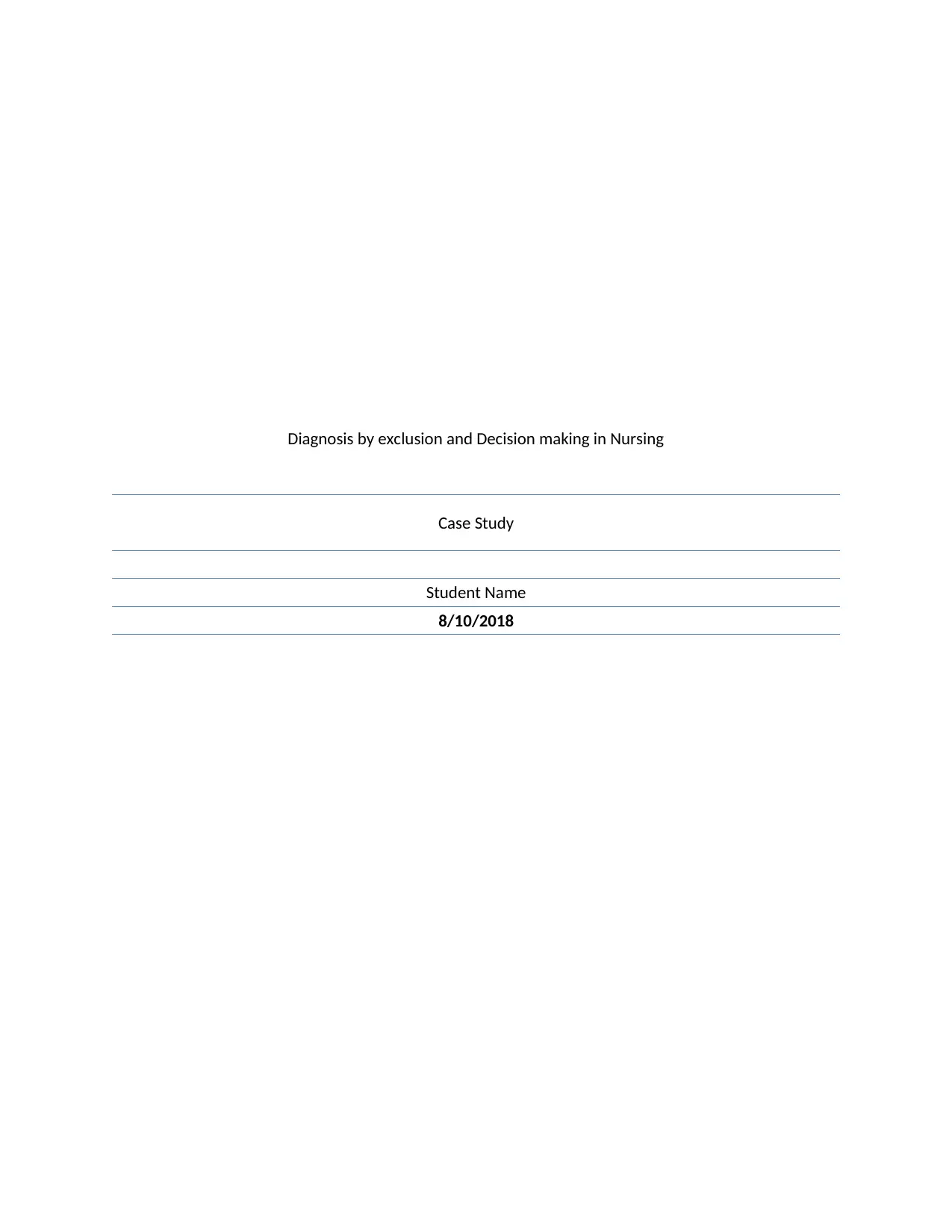
Diagnosis by exclusion and Decision making in Nursing
Case Study
Student Name
8/10/2018
Case Study
Student Name
8/10/2018
Secure Best Marks with AI Grader
Need help grading? Try our AI Grader for instant feedback on your assignments.
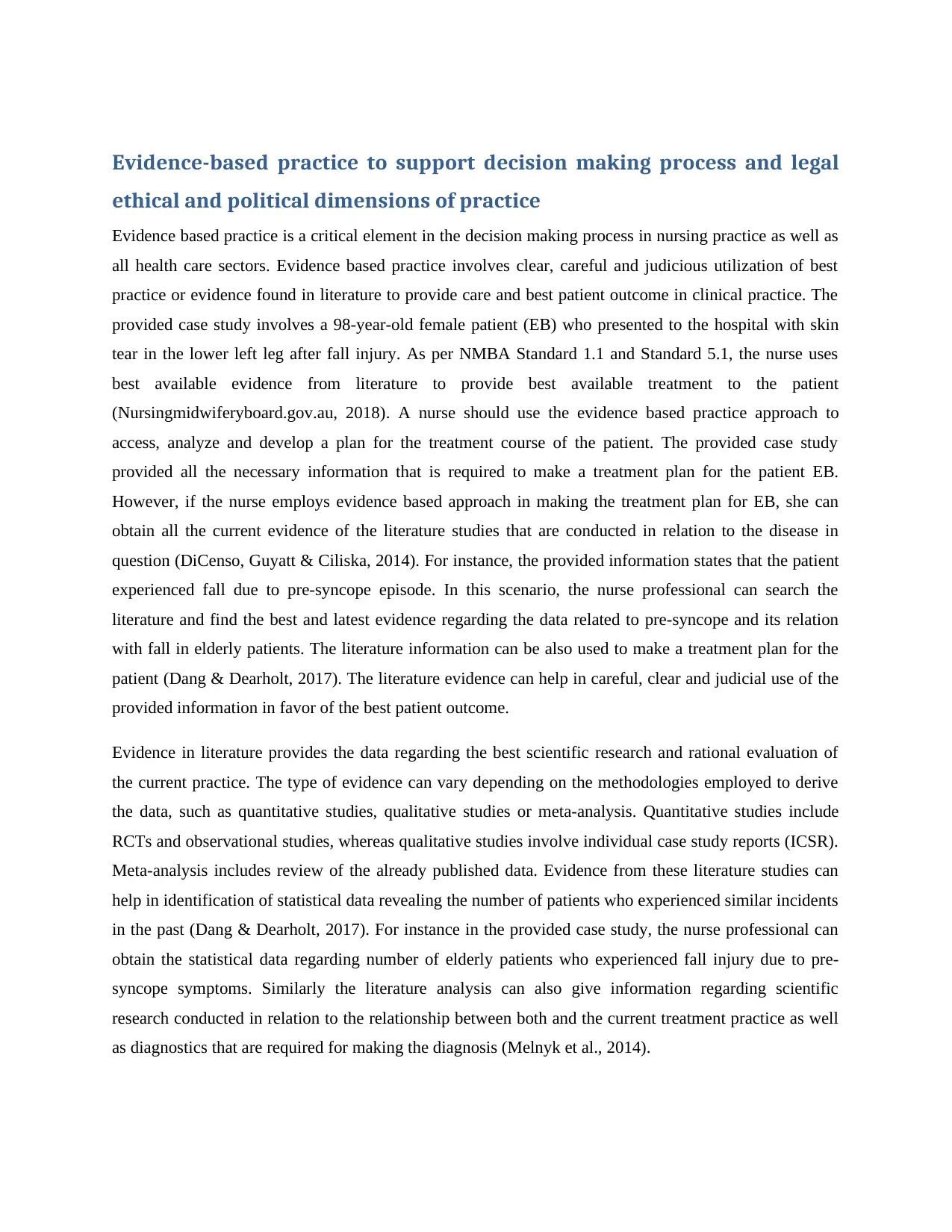
Evidence-based practice to support decision making process and legal
ethical and political dimensions of practice
Evidence based practice is a critical element in the decision making process in nursing practice as well as
all health care sectors. Evidence based practice involves clear, careful and judicious utilization of best
practice or evidence found in literature to provide care and best patient outcome in clinical practice. The
provided case study involves a 98-year-old female patient (EB) who presented to the hospital with skin
tear in the lower left leg after fall injury. As per NMBA Standard 1.1 and Standard 5.1, the nurse uses
best available evidence from literature to provide best available treatment to the patient
(Nursingmidwiferyboard.gov.au, 2018). A nurse should use the evidence based practice approach to
access, analyze and develop a plan for the treatment course of the patient. The provided case study
provided all the necessary information that is required to make a treatment plan for the patient EB.
However, if the nurse employs evidence based approach in making the treatment plan for EB, she can
obtain all the current evidence of the literature studies that are conducted in relation to the disease in
question (DiCenso, Guyatt & Ciliska, 2014). For instance, the provided information states that the patient
experienced fall due to pre-syncope episode. In this scenario, the nurse professional can search the
literature and find the best and latest evidence regarding the data related to pre-syncope and its relation
with fall in elderly patients. The literature information can be also used to make a treatment plan for the
patient (Dang & Dearholt, 2017). The literature evidence can help in careful, clear and judicial use of the
provided information in favor of the best patient outcome.
Evidence in literature provides the data regarding the best scientific research and rational evaluation of
the current practice. The type of evidence can vary depending on the methodologies employed to derive
the data, such as quantitative studies, qualitative studies or meta-analysis. Quantitative studies include
RCTs and observational studies, whereas qualitative studies involve individual case study reports (ICSR).
Meta-analysis includes review of the already published data. Evidence from these literature studies can
help in identification of statistical data revealing the number of patients who experienced similar incidents
in the past (Dang & Dearholt, 2017). For instance in the provided case study, the nurse professional can
obtain the statistical data regarding number of elderly patients who experienced fall injury due to pre-
syncope symptoms. Similarly the literature analysis can also give information regarding scientific
research conducted in relation to the relationship between both and the current treatment practice as well
as diagnostics that are required for making the diagnosis (Melnyk et al., 2014).
ethical and political dimensions of practice
Evidence based practice is a critical element in the decision making process in nursing practice as well as
all health care sectors. Evidence based practice involves clear, careful and judicious utilization of best
practice or evidence found in literature to provide care and best patient outcome in clinical practice. The
provided case study involves a 98-year-old female patient (EB) who presented to the hospital with skin
tear in the lower left leg after fall injury. As per NMBA Standard 1.1 and Standard 5.1, the nurse uses
best available evidence from literature to provide best available treatment to the patient
(Nursingmidwiferyboard.gov.au, 2018). A nurse should use the evidence based practice approach to
access, analyze and develop a plan for the treatment course of the patient. The provided case study
provided all the necessary information that is required to make a treatment plan for the patient EB.
However, if the nurse employs evidence based approach in making the treatment plan for EB, she can
obtain all the current evidence of the literature studies that are conducted in relation to the disease in
question (DiCenso, Guyatt & Ciliska, 2014). For instance, the provided information states that the patient
experienced fall due to pre-syncope episode. In this scenario, the nurse professional can search the
literature and find the best and latest evidence regarding the data related to pre-syncope and its relation
with fall in elderly patients. The literature information can be also used to make a treatment plan for the
patient (Dang & Dearholt, 2017). The literature evidence can help in careful, clear and judicial use of the
provided information in favor of the best patient outcome.
Evidence in literature provides the data regarding the best scientific research and rational evaluation of
the current practice. The type of evidence can vary depending on the methodologies employed to derive
the data, such as quantitative studies, qualitative studies or meta-analysis. Quantitative studies include
RCTs and observational studies, whereas qualitative studies involve individual case study reports (ICSR).
Meta-analysis includes review of the already published data. Evidence from these literature studies can
help in identification of statistical data revealing the number of patients who experienced similar incidents
in the past (Dang & Dearholt, 2017). For instance in the provided case study, the nurse professional can
obtain the statistical data regarding number of elderly patients who experienced fall injury due to pre-
syncope symptoms. Similarly the literature analysis can also give information regarding scientific
research conducted in relation to the relationship between both and the current treatment practice as well
as diagnostics that are required for making the diagnosis (Melnyk et al., 2014).
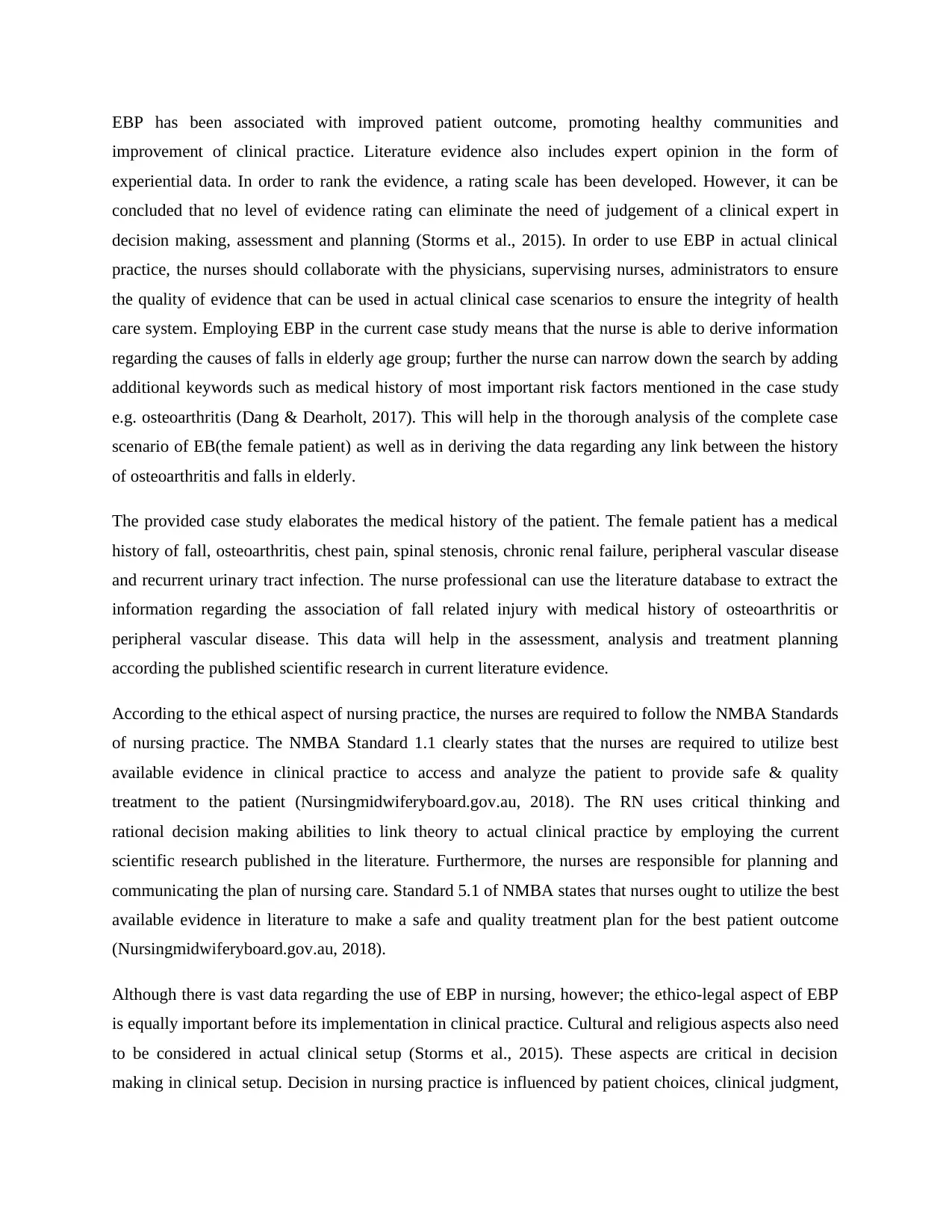
EBP has been associated with improved patient outcome, promoting healthy communities and
improvement of clinical practice. Literature evidence also includes expert opinion in the form of
experiential data. In order to rank the evidence, a rating scale has been developed. However, it can be
concluded that no level of evidence rating can eliminate the need of judgement of a clinical expert in
decision making, assessment and planning (Storms et al., 2015). In order to use EBP in actual clinical
practice, the nurses should collaborate with the physicians, supervising nurses, administrators to ensure
the quality of evidence that can be used in actual clinical case scenarios to ensure the integrity of health
care system. Employing EBP in the current case study means that the nurse is able to derive information
regarding the causes of falls in elderly age group; further the nurse can narrow down the search by adding
additional keywords such as medical history of most important risk factors mentioned in the case study
e.g. osteoarthritis (Dang & Dearholt, 2017). This will help in the thorough analysis of the complete case
scenario of EB(the female patient) as well as in deriving the data regarding any link between the history
of osteoarthritis and falls in elderly.
The provided case study elaborates the medical history of the patient. The female patient has a medical
history of fall, osteoarthritis, chest pain, spinal stenosis, chronic renal failure, peripheral vascular disease
and recurrent urinary tract infection. The nurse professional can use the literature database to extract the
information regarding the association of fall related injury with medical history of osteoarthritis or
peripheral vascular disease. This data will help in the assessment, analysis and treatment planning
according the published scientific research in current literature evidence.
According to the ethical aspect of nursing practice, the nurses are required to follow the NMBA Standards
of nursing practice. The NMBA Standard 1.1 clearly states that the nurses are required to utilize best
available evidence in clinical practice to access and analyze the patient to provide safe & quality
treatment to the patient (Nursingmidwiferyboard.gov.au, 2018). The RN uses critical thinking and
rational decision making abilities to link theory to actual clinical practice by employing the current
scientific research published in the literature. Furthermore, the nurses are responsible for planning and
communicating the plan of nursing care. Standard 5.1 of NMBA states that nurses ought to utilize the best
available evidence in literature to make a safe and quality treatment plan for the best patient outcome
(Nursingmidwiferyboard.gov.au, 2018).
Although there is vast data regarding the use of EBP in nursing, however; the ethico-legal aspect of EBP
is equally important before its implementation in clinical practice. Cultural and religious aspects also need
to be considered in actual clinical setup (Storms et al., 2015). These aspects are critical in decision
making in clinical setup. Decision in nursing practice is influenced by patient choices, clinical judgment,
improvement of clinical practice. Literature evidence also includes expert opinion in the form of
experiential data. In order to rank the evidence, a rating scale has been developed. However, it can be
concluded that no level of evidence rating can eliminate the need of judgement of a clinical expert in
decision making, assessment and planning (Storms et al., 2015). In order to use EBP in actual clinical
practice, the nurses should collaborate with the physicians, supervising nurses, administrators to ensure
the quality of evidence that can be used in actual clinical case scenarios to ensure the integrity of health
care system. Employing EBP in the current case study means that the nurse is able to derive information
regarding the causes of falls in elderly age group; further the nurse can narrow down the search by adding
additional keywords such as medical history of most important risk factors mentioned in the case study
e.g. osteoarthritis (Dang & Dearholt, 2017). This will help in the thorough analysis of the complete case
scenario of EB(the female patient) as well as in deriving the data regarding any link between the history
of osteoarthritis and falls in elderly.
The provided case study elaborates the medical history of the patient. The female patient has a medical
history of fall, osteoarthritis, chest pain, spinal stenosis, chronic renal failure, peripheral vascular disease
and recurrent urinary tract infection. The nurse professional can use the literature database to extract the
information regarding the association of fall related injury with medical history of osteoarthritis or
peripheral vascular disease. This data will help in the assessment, analysis and treatment planning
according the published scientific research in current literature evidence.
According to the ethical aspect of nursing practice, the nurses are required to follow the NMBA Standards
of nursing practice. The NMBA Standard 1.1 clearly states that the nurses are required to utilize best
available evidence in clinical practice to access and analyze the patient to provide safe & quality
treatment to the patient (Nursingmidwiferyboard.gov.au, 2018). The RN uses critical thinking and
rational decision making abilities to link theory to actual clinical practice by employing the current
scientific research published in the literature. Furthermore, the nurses are responsible for planning and
communicating the plan of nursing care. Standard 5.1 of NMBA states that nurses ought to utilize the best
available evidence in literature to make a safe and quality treatment plan for the best patient outcome
(Nursingmidwiferyboard.gov.au, 2018).
Although there is vast data regarding the use of EBP in nursing, however; the ethico-legal aspect of EBP
is equally important before its implementation in clinical practice. Cultural and religious aspects also need
to be considered in actual clinical setup (Storms et al., 2015). These aspects are critical in decision
making in clinical setup. Decision in nursing practice is influenced by patient choices, clinical judgment,
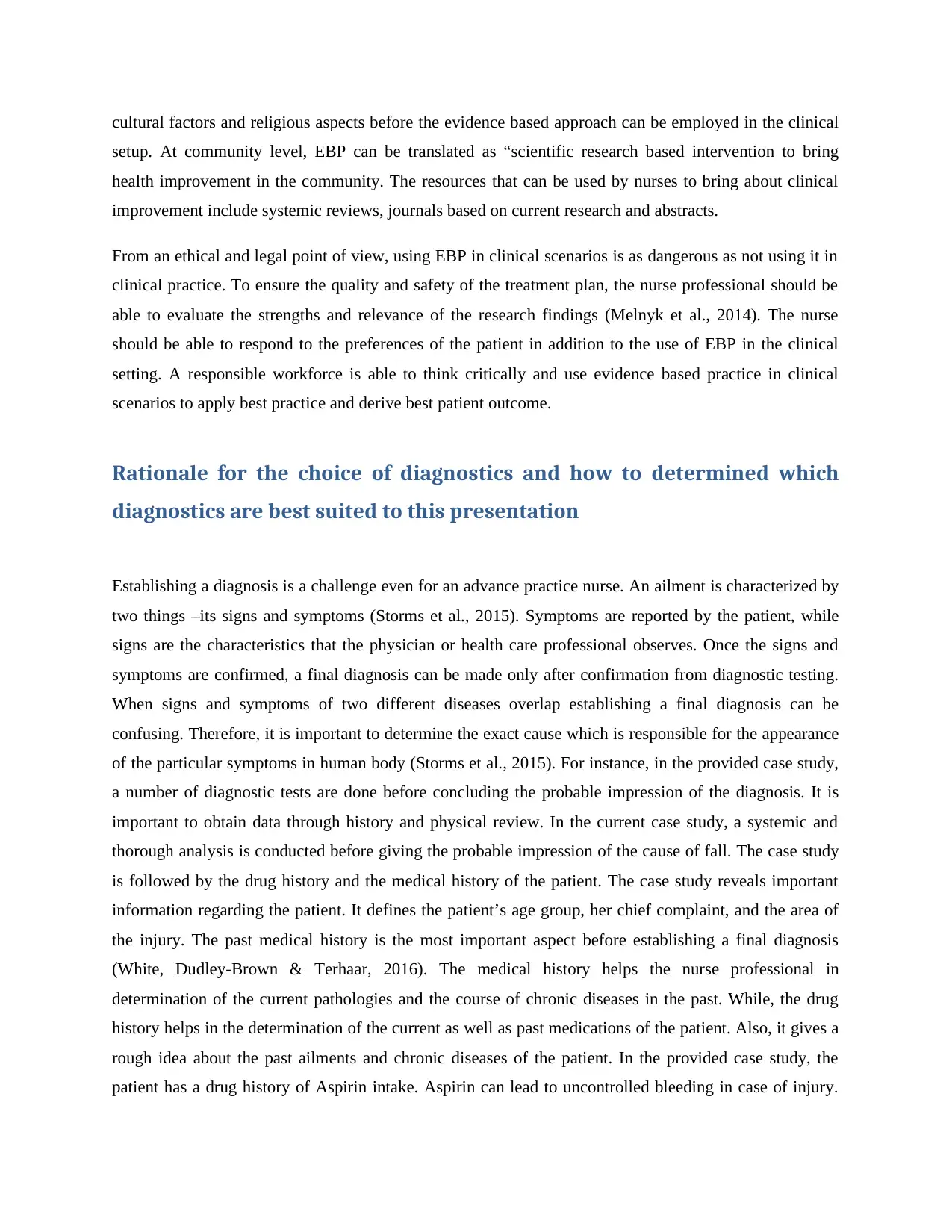
cultural factors and religious aspects before the evidence based approach can be employed in the clinical
setup. At community level, EBP can be translated as “scientific research based intervention to bring
health improvement in the community. The resources that can be used by nurses to bring about clinical
improvement include systemic reviews, journals based on current research and abstracts.
From an ethical and legal point of view, using EBP in clinical scenarios is as dangerous as not using it in
clinical practice. To ensure the quality and safety of the treatment plan, the nurse professional should be
able to evaluate the strengths and relevance of the research findings (Melnyk et al., 2014). The nurse
should be able to respond to the preferences of the patient in addition to the use of EBP in the clinical
setting. A responsible workforce is able to think critically and use evidence based practice in clinical
scenarios to apply best practice and derive best patient outcome.
Rationale for the choice of diagnostics and how to determined which
diagnostics are best suited to this presentation
Establishing a diagnosis is a challenge even for an advance practice nurse. An ailment is characterized by
two things –its signs and symptoms (Storms et al., 2015). Symptoms are reported by the patient, while
signs are the characteristics that the physician or health care professional observes. Once the signs and
symptoms are confirmed, a final diagnosis can be made only after confirmation from diagnostic testing.
When signs and symptoms of two different diseases overlap establishing a final diagnosis can be
confusing. Therefore, it is important to determine the exact cause which is responsible for the appearance
of the particular symptoms in human body (Storms et al., 2015). For instance, in the provided case study,
a number of diagnostic tests are done before concluding the probable impression of the diagnosis. It is
important to obtain data through history and physical review. In the current case study, a systemic and
thorough analysis is conducted before giving the probable impression of the cause of fall. The case study
is followed by the drug history and the medical history of the patient. The case study reveals important
information regarding the patient. It defines the patient’s age group, her chief complaint, and the area of
the injury. The past medical history is the most important aspect before establishing a final diagnosis
(White, Dudley-Brown & Terhaar, 2016). The medical history helps the nurse professional in
determination of the current pathologies and the course of chronic diseases in the past. While, the drug
history helps in the determination of the current as well as past medications of the patient. Also, it gives a
rough idea about the past ailments and chronic diseases of the patient. In the provided case study, the
patient has a drug history of Aspirin intake. Aspirin can lead to uncontrolled bleeding in case of injury.
setup. At community level, EBP can be translated as “scientific research based intervention to bring
health improvement in the community. The resources that can be used by nurses to bring about clinical
improvement include systemic reviews, journals based on current research and abstracts.
From an ethical and legal point of view, using EBP in clinical scenarios is as dangerous as not using it in
clinical practice. To ensure the quality and safety of the treatment plan, the nurse professional should be
able to evaluate the strengths and relevance of the research findings (Melnyk et al., 2014). The nurse
should be able to respond to the preferences of the patient in addition to the use of EBP in the clinical
setting. A responsible workforce is able to think critically and use evidence based practice in clinical
scenarios to apply best practice and derive best patient outcome.
Rationale for the choice of diagnostics and how to determined which
diagnostics are best suited to this presentation
Establishing a diagnosis is a challenge even for an advance practice nurse. An ailment is characterized by
two things –its signs and symptoms (Storms et al., 2015). Symptoms are reported by the patient, while
signs are the characteristics that the physician or health care professional observes. Once the signs and
symptoms are confirmed, a final diagnosis can be made only after confirmation from diagnostic testing.
When signs and symptoms of two different diseases overlap establishing a final diagnosis can be
confusing. Therefore, it is important to determine the exact cause which is responsible for the appearance
of the particular symptoms in human body (Storms et al., 2015). For instance, in the provided case study,
a number of diagnostic tests are done before concluding the probable impression of the diagnosis. It is
important to obtain data through history and physical review. In the current case study, a systemic and
thorough analysis is conducted before giving the probable impression of the cause of fall. The case study
is followed by the drug history and the medical history of the patient. The case study reveals important
information regarding the patient. It defines the patient’s age group, her chief complaint, and the area of
the injury. The past medical history is the most important aspect before establishing a final diagnosis
(White, Dudley-Brown & Terhaar, 2016). The medical history helps the nurse professional in
determination of the current pathologies and the course of chronic diseases in the past. While, the drug
history helps in the determination of the current as well as past medications of the patient. Also, it gives a
rough idea about the past ailments and chronic diseases of the patient. In the provided case study, the
patient has a drug history of Aspirin intake. Aspirin can lead to uncontrolled bleeding in case of injury.
Secure Best Marks with AI Grader
Need help grading? Try our AI Grader for instant feedback on your assignments.
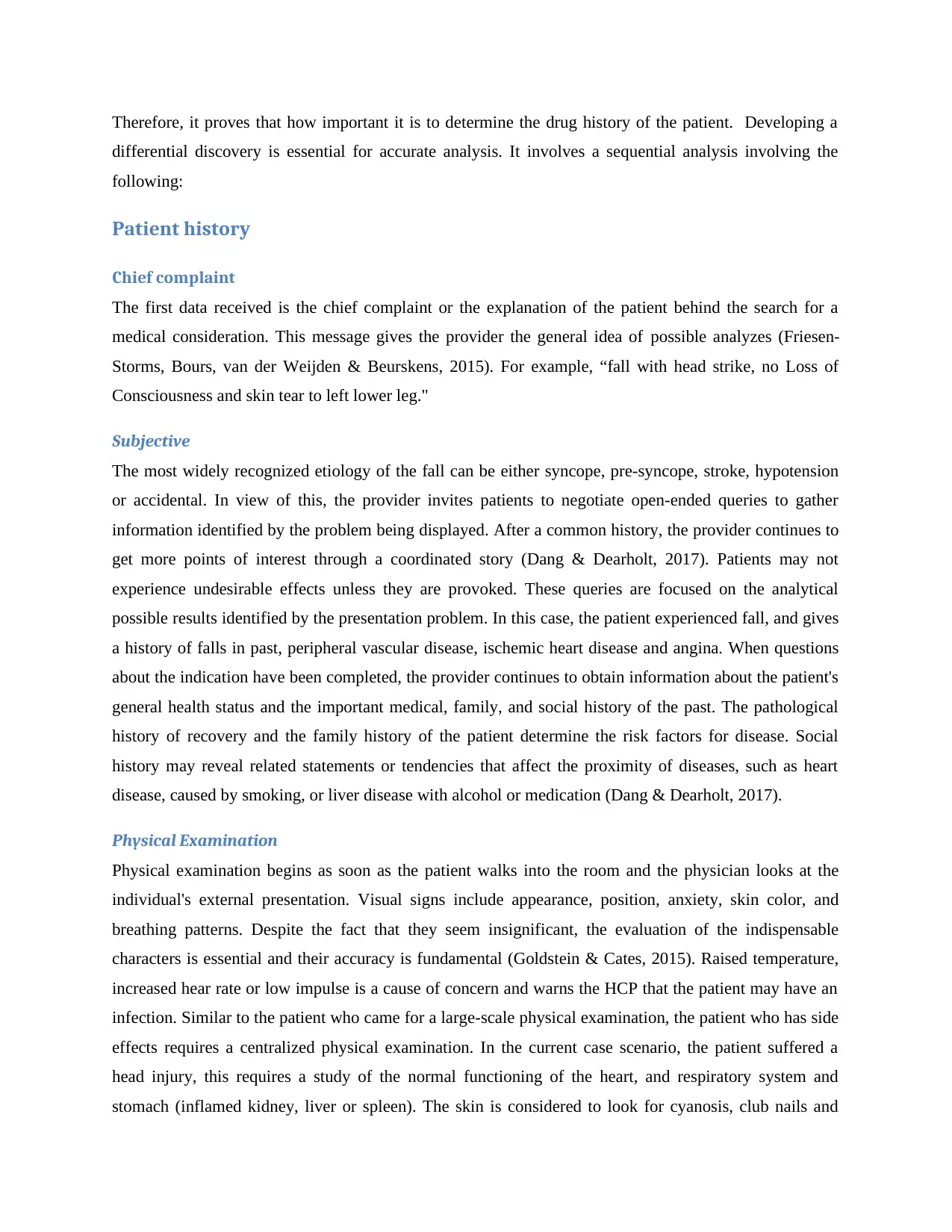
Therefore, it proves that how important it is to determine the drug history of the patient. Developing a
differential discovery is essential for accurate analysis. It involves a sequential analysis involving the
following:
Patient history
Chief complaint
The first data received is the chief complaint or the explanation of the patient behind the search for a
medical consideration. This message gives the provider the general idea of possible analyzes (Friesen-
Storms, Bours, van der Weijden & Beurskens, 2015). For example, “fall with head strike, no Loss of
Consciousness and skin tear to left lower leg."
Subjective
The most widely recognized etiology of the fall can be either syncope, pre-syncope, stroke, hypotension
or accidental. In view of this, the provider invites patients to negotiate open-ended queries to gather
information identified by the problem being displayed. After a common history, the provider continues to
get more points of interest through a coordinated story (Dang & Dearholt, 2017). Patients may not
experience undesirable effects unless they are provoked. These queries are focused on the analytical
possible results identified by the presentation problem. In this case, the patient experienced fall, and gives
a history of falls in past, peripheral vascular disease, ischemic heart disease and angina. When questions
about the indication have been completed, the provider continues to obtain information about the patient's
general health status and the important medical, family, and social history of the past. The pathological
history of recovery and the family history of the patient determine the risk factors for disease. Social
history may reveal related statements or tendencies that affect the proximity of diseases, such as heart
disease, caused by smoking, or liver disease with alcohol or medication (Dang & Dearholt, 2017).
Physical Examination
Physical examination begins as soon as the patient walks into the room and the physician looks at the
individual's external presentation. Visual signs include appearance, position, anxiety, skin color, and
breathing patterns. Despite the fact that they seem insignificant, the evaluation of the indispensable
characters is essential and their accuracy is fundamental (Goldstein & Cates, 2015). Raised temperature,
increased hear rate or low impulse is a cause of concern and warns the HCP that the patient may have an
infection. Similar to the patient who came for a large-scale physical examination, the patient who has side
effects requires a centralized physical examination. In the current case scenario, the patient suffered a
head injury, this requires a study of the normal functioning of the heart, and respiratory system and
stomach (inflamed kidney, liver or spleen). The skin is considered to look for cyanosis, club nails and
differential discovery is essential for accurate analysis. It involves a sequential analysis involving the
following:
Patient history
Chief complaint
The first data received is the chief complaint or the explanation of the patient behind the search for a
medical consideration. This message gives the provider the general idea of possible analyzes (Friesen-
Storms, Bours, van der Weijden & Beurskens, 2015). For example, “fall with head strike, no Loss of
Consciousness and skin tear to left lower leg."
Subjective
The most widely recognized etiology of the fall can be either syncope, pre-syncope, stroke, hypotension
or accidental. In view of this, the provider invites patients to negotiate open-ended queries to gather
information identified by the problem being displayed. After a common history, the provider continues to
get more points of interest through a coordinated story (Dang & Dearholt, 2017). Patients may not
experience undesirable effects unless they are provoked. These queries are focused on the analytical
possible results identified by the presentation problem. In this case, the patient experienced fall, and gives
a history of falls in past, peripheral vascular disease, ischemic heart disease and angina. When questions
about the indication have been completed, the provider continues to obtain information about the patient's
general health status and the important medical, family, and social history of the past. The pathological
history of recovery and the family history of the patient determine the risk factors for disease. Social
history may reveal related statements or tendencies that affect the proximity of diseases, such as heart
disease, caused by smoking, or liver disease with alcohol or medication (Dang & Dearholt, 2017).
Physical Examination
Physical examination begins as soon as the patient walks into the room and the physician looks at the
individual's external presentation. Visual signs include appearance, position, anxiety, skin color, and
breathing patterns. Despite the fact that they seem insignificant, the evaluation of the indispensable
characters is essential and their accuracy is fundamental (Goldstein & Cates, 2015). Raised temperature,
increased hear rate or low impulse is a cause of concern and warns the HCP that the patient may have an
infection. Similar to the patient who came for a large-scale physical examination, the patient who has side
effects requires a centralized physical examination. In the current case scenario, the patient suffered a
head injury, this requires a study of the normal functioning of the heart, and respiratory system and
stomach (inflamed kidney, liver or spleen). The skin is considered to look for cyanosis, club nails and
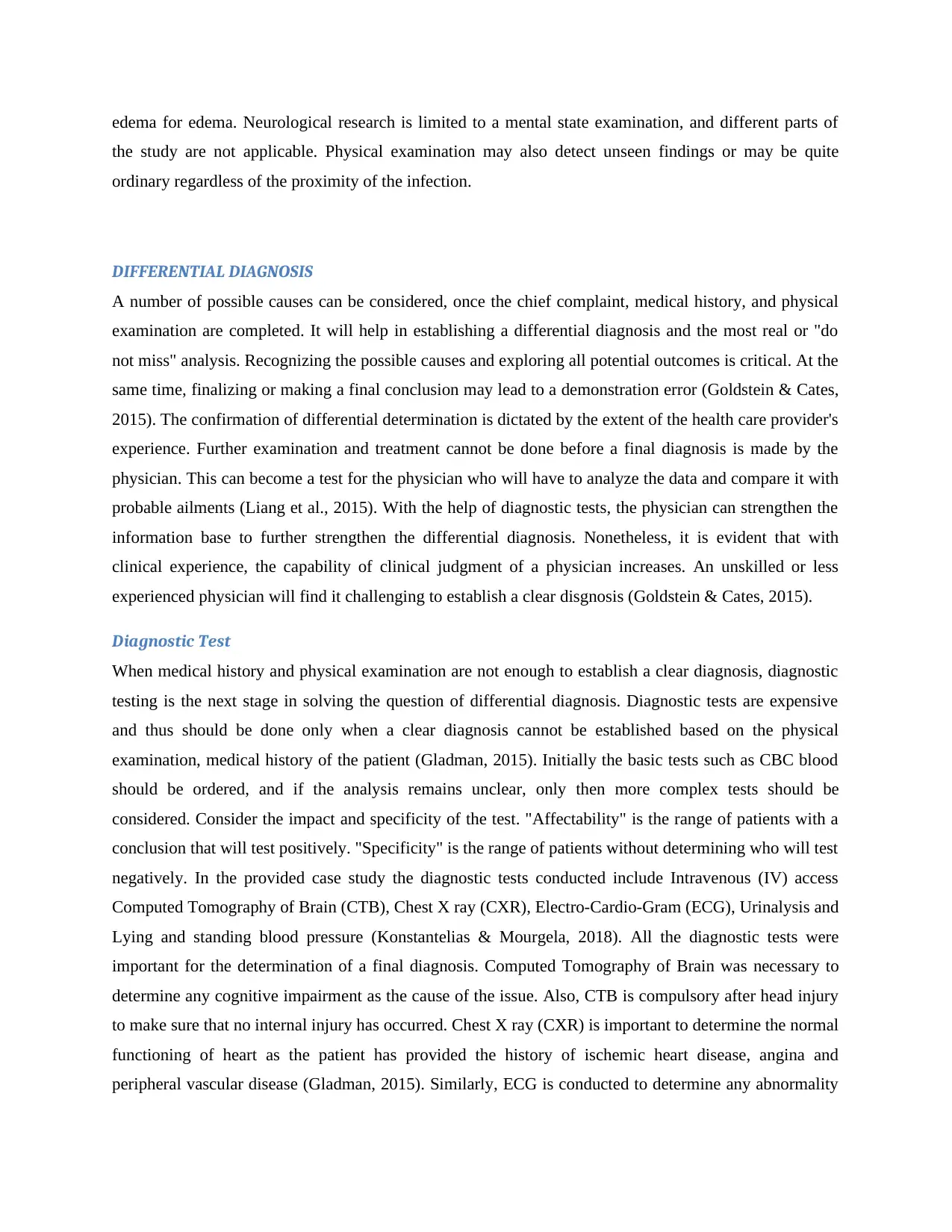
edema for edema. Neurological research is limited to a mental state examination, and different parts of
the study are not applicable. Physical examination may also detect unseen findings or may be quite
ordinary regardless of the proximity of the infection.
DIFFERENTIAL DIAGNOSIS
A number of possible causes can be considered, once the chief complaint, medical history, and physical
examination are completed. It will help in establishing a differential diagnosis and the most real or "do
not miss" analysis. Recognizing the possible causes and exploring all potential outcomes is critical. At the
same time, finalizing or making a final conclusion may lead to a demonstration error (Goldstein & Cates,
2015). The confirmation of differential determination is dictated by the extent of the health care provider's
experience. Further examination and treatment cannot be done before a final diagnosis is made by the
physician. This can become a test for the physician who will have to analyze the data and compare it with
probable ailments (Liang et al., 2015). With the help of diagnostic tests, the physician can strengthen the
information base to further strengthen the differential diagnosis. Nonetheless, it is evident that with
clinical experience, the capability of clinical judgment of a physician increases. An unskilled or less
experienced physician will find it challenging to establish a clear disgnosis (Goldstein & Cates, 2015).
Diagnostic Test
When medical history and physical examination are not enough to establish a clear diagnosis, diagnostic
testing is the next stage in solving the question of differential diagnosis. Diagnostic tests are expensive
and thus should be done only when a clear diagnosis cannot be established based on the physical
examination, medical history of the patient (Gladman, 2015). Initially the basic tests such as CBC blood
should be ordered, and if the analysis remains unclear, only then more complex tests should be
considered. Consider the impact and specificity of the test. "Affectability" is the range of patients with a
conclusion that will test positively. "Specificity" is the range of patients without determining who will test
negatively. In the provided case study the diagnostic tests conducted include Intravenous (IV) access
Computed Tomography of Brain (CTB), Chest X ray (CXR), Electro-Cardio-Gram (ECG), Urinalysis and
Lying and standing blood pressure (Konstantelias & Mourgela, 2018). All the diagnostic tests were
important for the determination of a final diagnosis. Computed Tomography of Brain was necessary to
determine any cognitive impairment as the cause of the issue. Also, CTB is compulsory after head injury
to make sure that no internal injury has occurred. Chest X ray (CXR) is important to determine the normal
functioning of heart as the patient has provided the history of ischemic heart disease, angina and
peripheral vascular disease (Gladman, 2015). Similarly, ECG is conducted to determine any abnormality
the study are not applicable. Physical examination may also detect unseen findings or may be quite
ordinary regardless of the proximity of the infection.
DIFFERENTIAL DIAGNOSIS
A number of possible causes can be considered, once the chief complaint, medical history, and physical
examination are completed. It will help in establishing a differential diagnosis and the most real or "do
not miss" analysis. Recognizing the possible causes and exploring all potential outcomes is critical. At the
same time, finalizing or making a final conclusion may lead to a demonstration error (Goldstein & Cates,
2015). The confirmation of differential determination is dictated by the extent of the health care provider's
experience. Further examination and treatment cannot be done before a final diagnosis is made by the
physician. This can become a test for the physician who will have to analyze the data and compare it with
probable ailments (Liang et al., 2015). With the help of diagnostic tests, the physician can strengthen the
information base to further strengthen the differential diagnosis. Nonetheless, it is evident that with
clinical experience, the capability of clinical judgment of a physician increases. An unskilled or less
experienced physician will find it challenging to establish a clear disgnosis (Goldstein & Cates, 2015).
Diagnostic Test
When medical history and physical examination are not enough to establish a clear diagnosis, diagnostic
testing is the next stage in solving the question of differential diagnosis. Diagnostic tests are expensive
and thus should be done only when a clear diagnosis cannot be established based on the physical
examination, medical history of the patient (Gladman, 2015). Initially the basic tests such as CBC blood
should be ordered, and if the analysis remains unclear, only then more complex tests should be
considered. Consider the impact and specificity of the test. "Affectability" is the range of patients with a
conclusion that will test positively. "Specificity" is the range of patients without determining who will test
negatively. In the provided case study the diagnostic tests conducted include Intravenous (IV) access
Computed Tomography of Brain (CTB), Chest X ray (CXR), Electro-Cardio-Gram (ECG), Urinalysis and
Lying and standing blood pressure (Konstantelias & Mourgela, 2018). All the diagnostic tests were
important for the determination of a final diagnosis. Computed Tomography of Brain was necessary to
determine any cognitive impairment as the cause of the issue. Also, CTB is compulsory after head injury
to make sure that no internal injury has occurred. Chest X ray (CXR) is important to determine the normal
functioning of heart as the patient has provided the history of ischemic heart disease, angina and
peripheral vascular disease (Gladman, 2015). Similarly, ECG is conducted to determine any abnormality
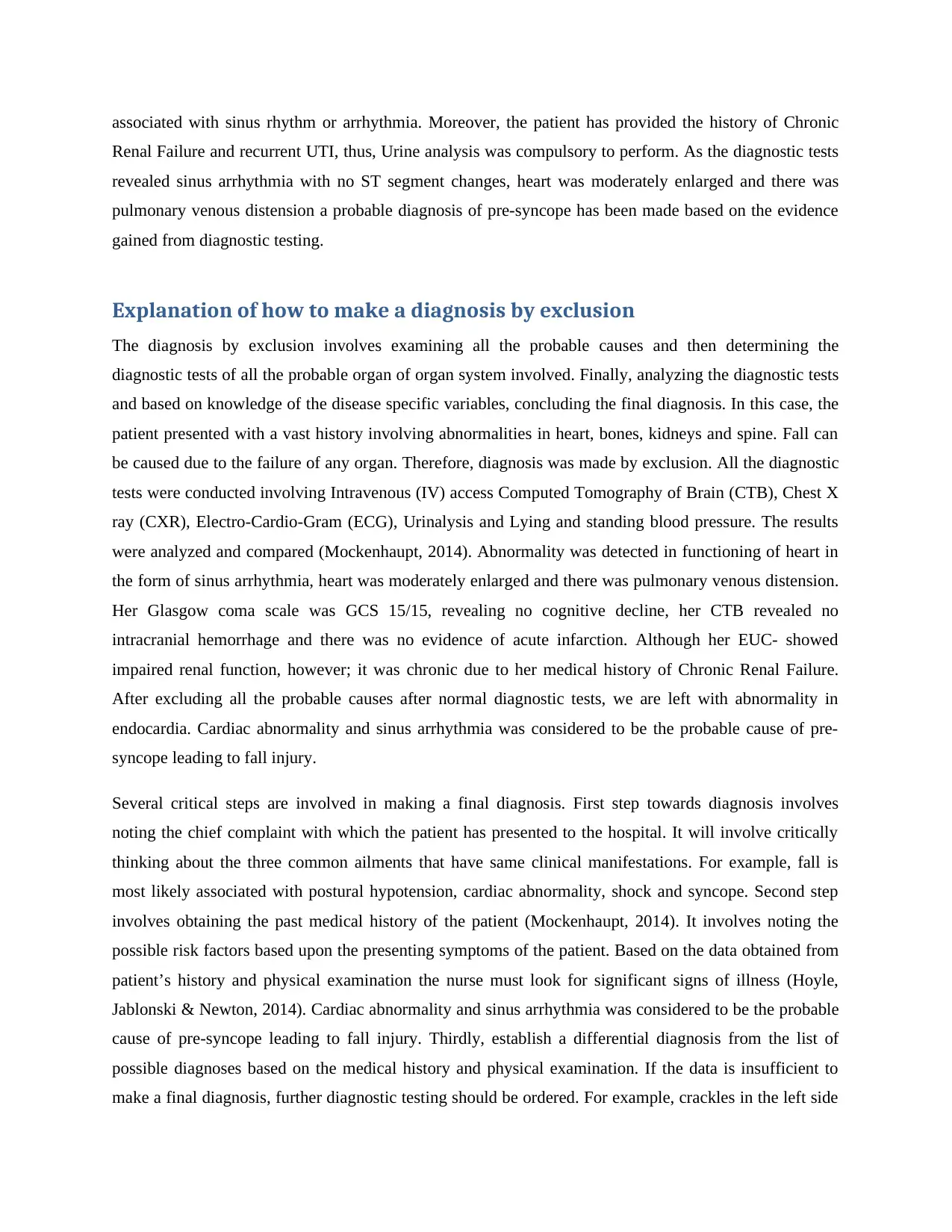
associated with sinus rhythm or arrhythmia. Moreover, the patient has provided the history of Chronic
Renal Failure and recurrent UTI, thus, Urine analysis was compulsory to perform. As the diagnostic tests
revealed sinus arrhythmia with no ST segment changes, heart was moderately enlarged and there was
pulmonary venous distension a probable diagnosis of pre-syncope has been made based on the evidence
gained from diagnostic testing.
Explanation of how to make a diagnosis by exclusion
The diagnosis by exclusion involves examining all the probable causes and then determining the
diagnostic tests of all the probable organ of organ system involved. Finally, analyzing the diagnostic tests
and based on knowledge of the disease specific variables, concluding the final diagnosis. In this case, the
patient presented with a vast history involving abnormalities in heart, bones, kidneys and spine. Fall can
be caused due to the failure of any organ. Therefore, diagnosis was made by exclusion. All the diagnostic
tests were conducted involving Intravenous (IV) access Computed Tomography of Brain (CTB), Chest X
ray (CXR), Electro-Cardio-Gram (ECG), Urinalysis and Lying and standing blood pressure. The results
were analyzed and compared (Mockenhaupt, 2014). Abnormality was detected in functioning of heart in
the form of sinus arrhythmia, heart was moderately enlarged and there was pulmonary venous distension.
Her Glasgow coma scale was GCS 15/15, revealing no cognitive decline, her CTB revealed no
intracranial hemorrhage and there was no evidence of acute infarction. Although her EUC- showed
impaired renal function, however; it was chronic due to her medical history of Chronic Renal Failure.
After excluding all the probable causes after normal diagnostic tests, we are left with abnormality in
endocardia. Cardiac abnormality and sinus arrhythmia was considered to be the probable cause of pre-
syncope leading to fall injury.
Several critical steps are involved in making a final diagnosis. First step towards diagnosis involves
noting the chief complaint with which the patient has presented to the hospital. It will involve critically
thinking about the three common ailments that have same clinical manifestations. For example, fall is
most likely associated with postural hypotension, cardiac abnormality, shock and syncope. Second step
involves obtaining the past medical history of the patient (Mockenhaupt, 2014). It involves noting the
possible risk factors based upon the presenting symptoms of the patient. Based on the data obtained from
patient’s history and physical examination the nurse must look for significant signs of illness (Hoyle,
Jablonski & Newton, 2014). Cardiac abnormality and sinus arrhythmia was considered to be the probable
cause of pre-syncope leading to fall injury. Thirdly, establish a differential diagnosis from the list of
possible diagnoses based on the medical history and physical examination. If the data is insufficient to
make a final diagnosis, further diagnostic testing should be ordered. For example, crackles in the left side
Renal Failure and recurrent UTI, thus, Urine analysis was compulsory to perform. As the diagnostic tests
revealed sinus arrhythmia with no ST segment changes, heart was moderately enlarged and there was
pulmonary venous distension a probable diagnosis of pre-syncope has been made based on the evidence
gained from diagnostic testing.
Explanation of how to make a diagnosis by exclusion
The diagnosis by exclusion involves examining all the probable causes and then determining the
diagnostic tests of all the probable organ of organ system involved. Finally, analyzing the diagnostic tests
and based on knowledge of the disease specific variables, concluding the final diagnosis. In this case, the
patient presented with a vast history involving abnormalities in heart, bones, kidneys and spine. Fall can
be caused due to the failure of any organ. Therefore, diagnosis was made by exclusion. All the diagnostic
tests were conducted involving Intravenous (IV) access Computed Tomography of Brain (CTB), Chest X
ray (CXR), Electro-Cardio-Gram (ECG), Urinalysis and Lying and standing blood pressure. The results
were analyzed and compared (Mockenhaupt, 2014). Abnormality was detected in functioning of heart in
the form of sinus arrhythmia, heart was moderately enlarged and there was pulmonary venous distension.
Her Glasgow coma scale was GCS 15/15, revealing no cognitive decline, her CTB revealed no
intracranial hemorrhage and there was no evidence of acute infarction. Although her EUC- showed
impaired renal function, however; it was chronic due to her medical history of Chronic Renal Failure.
After excluding all the probable causes after normal diagnostic tests, we are left with abnormality in
endocardia. Cardiac abnormality and sinus arrhythmia was considered to be the probable cause of pre-
syncope leading to fall injury.
Several critical steps are involved in making a final diagnosis. First step towards diagnosis involves
noting the chief complaint with which the patient has presented to the hospital. It will involve critically
thinking about the three common ailments that have same clinical manifestations. For example, fall is
most likely associated with postural hypotension, cardiac abnormality, shock and syncope. Second step
involves obtaining the past medical history of the patient (Mockenhaupt, 2014). It involves noting the
possible risk factors based upon the presenting symptoms of the patient. Based on the data obtained from
patient’s history and physical examination the nurse must look for significant signs of illness (Hoyle,
Jablonski & Newton, 2014). Cardiac abnormality and sinus arrhythmia was considered to be the probable
cause of pre-syncope leading to fall injury. Thirdly, establish a differential diagnosis from the list of
possible diagnoses based on the medical history and physical examination. If the data is insufficient to
make a final diagnosis, further diagnostic testing should be ordered. For example, crackles in the left side
Paraphrase This Document
Need a fresh take? Get an instant paraphrase of this document with our AI Paraphraser
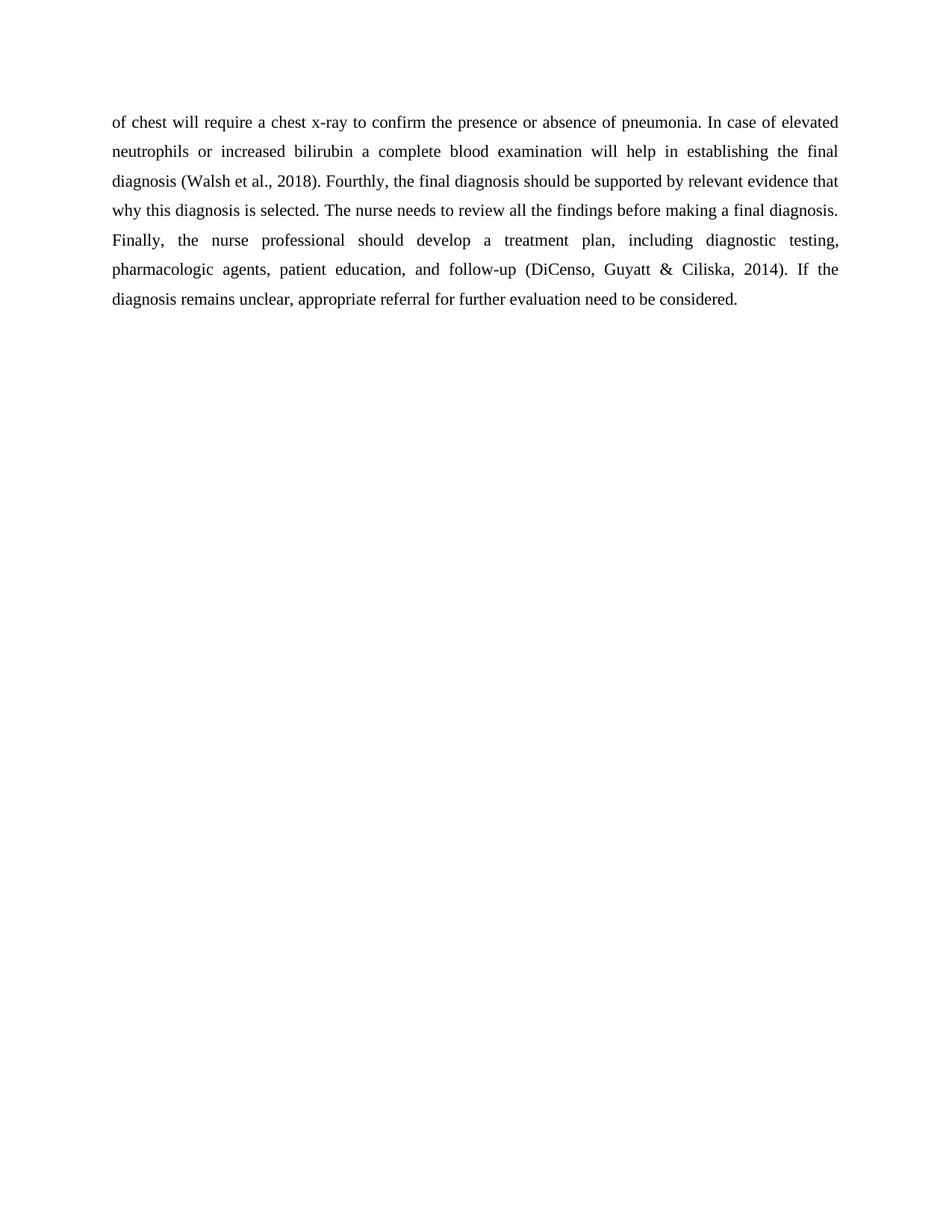
of chest will require a chest x-ray to confirm the presence or absence of pneumonia. In case of elevated
neutrophils or increased bilirubin a complete blood examination will help in establishing the final
diagnosis (Walsh et al., 2018). Fourthly, the final diagnosis should be supported by relevant evidence that
why this diagnosis is selected. The nurse needs to review all the findings before making a final diagnosis.
Finally, the nurse professional should develop a treatment plan, including diagnostic testing,
pharmacologic agents, patient education, and follow-up (DiCenso, Guyatt & Ciliska, 2014). If the
diagnosis remains unclear, appropriate referral for further evaluation need to be considered.
neutrophils or increased bilirubin a complete blood examination will help in establishing the final
diagnosis (Walsh et al., 2018). Fourthly, the final diagnosis should be supported by relevant evidence that
why this diagnosis is selected. The nurse needs to review all the findings before making a final diagnosis.
Finally, the nurse professional should develop a treatment plan, including diagnostic testing,
pharmacologic agents, patient education, and follow-up (DiCenso, Guyatt & Ciliska, 2014). If the
diagnosis remains unclear, appropriate referral for further evaluation need to be considered.
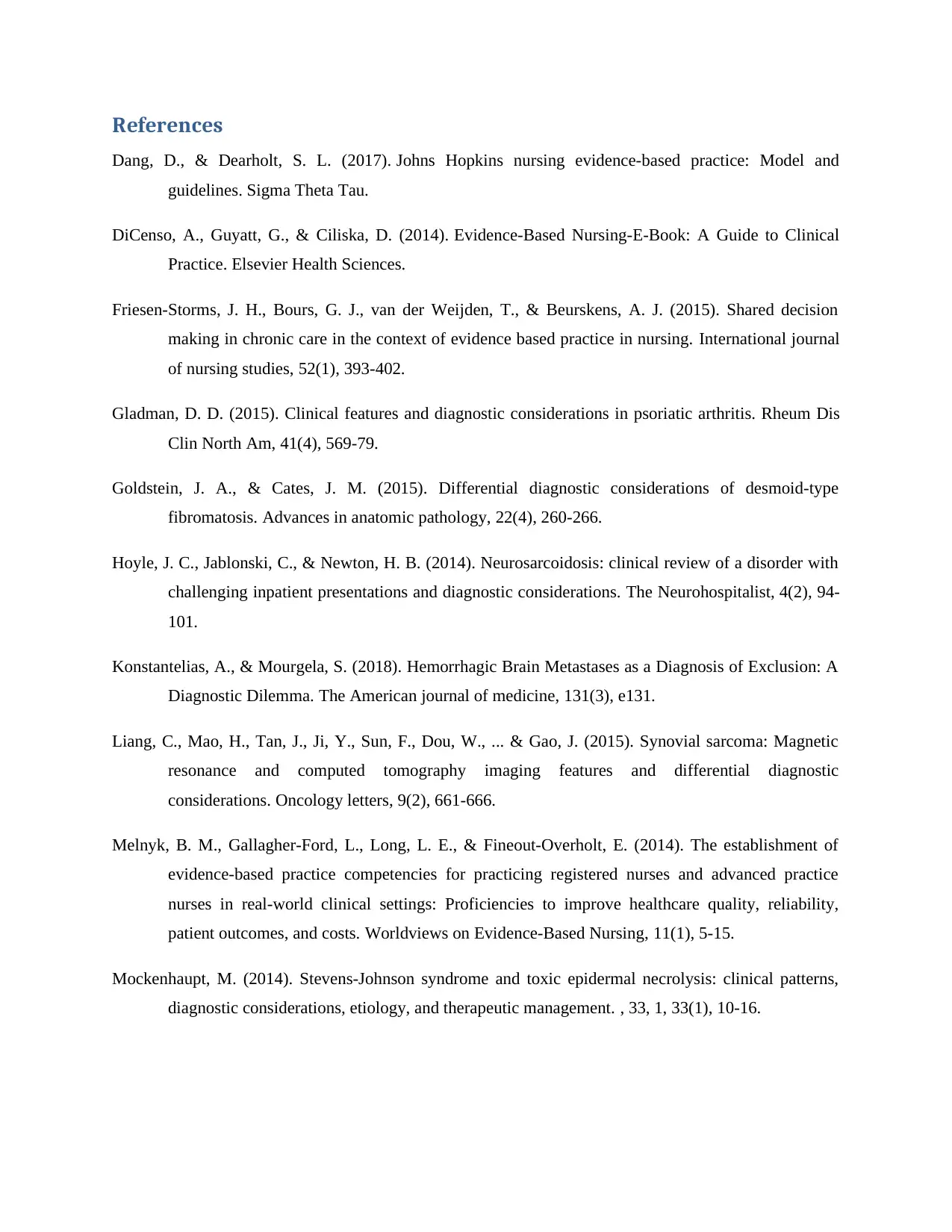
References
Dang, D., & Dearholt, S. L. (2017). Johns Hopkins nursing evidence-based practice: Model and
guidelines. Sigma Theta Tau.
DiCenso, A., Guyatt, G., & Ciliska, D. (2014). Evidence-Based Nursing-E-Book: A Guide to Clinical
Practice. Elsevier Health Sciences.
Friesen-Storms, J. H., Bours, G. J., van der Weijden, T., & Beurskens, A. J. (2015). Shared decision
making in chronic care in the context of evidence based practice in nursing. International journal
of nursing studies, 52(1), 393-402.
Gladman, D. D. (2015). Clinical features and diagnostic considerations in psoriatic arthritis. Rheum Dis
Clin North Am, 41(4), 569-79.
Goldstein, J. A., & Cates, J. M. (2015). Differential diagnostic considerations of desmoid-type
fibromatosis. Advances in anatomic pathology, 22(4), 260-266.
Hoyle, J. C., Jablonski, C., & Newton, H. B. (2014). Neurosarcoidosis: clinical review of a disorder with
challenging inpatient presentations and diagnostic considerations. The Neurohospitalist, 4(2), 94-
101.
Konstantelias, A., & Mourgela, S. (2018). Hemorrhagic Brain Metastases as a Diagnosis of Exclusion: A
Diagnostic Dilemma. The American journal of medicine, 131(3), e131.
Liang, C., Mao, H., Tan, J., Ji, Y., Sun, F., Dou, W., ... & Gao, J. (2015). Synovial sarcoma: Magnetic
resonance and computed tomography imaging features and differential diagnostic
considerations. Oncology letters, 9(2), 661-666.
Melnyk, B. M., Gallagher‐Ford, L., Long, L. E., & Fineout‐Overholt, E. (2014). The establishment of
evidence‐based practice competencies for practicing registered nurses and advanced practice
nurses in real‐world clinical settings: Proficiencies to improve healthcare quality, reliability,
patient outcomes, and costs. Worldviews on Evidence‐Based Nursing, 11(1), 5-15.
Mockenhaupt, M. (2014). Stevens-Johnson syndrome and toxic epidermal necrolysis: clinical patterns,
diagnostic considerations, etiology, and therapeutic management. , 33, 1, 33(1), 10-16.
Dang, D., & Dearholt, S. L. (2017). Johns Hopkins nursing evidence-based practice: Model and
guidelines. Sigma Theta Tau.
DiCenso, A., Guyatt, G., & Ciliska, D. (2014). Evidence-Based Nursing-E-Book: A Guide to Clinical
Practice. Elsevier Health Sciences.
Friesen-Storms, J. H., Bours, G. J., van der Weijden, T., & Beurskens, A. J. (2015). Shared decision
making in chronic care in the context of evidence based practice in nursing. International journal
of nursing studies, 52(1), 393-402.
Gladman, D. D. (2015). Clinical features and diagnostic considerations in psoriatic arthritis. Rheum Dis
Clin North Am, 41(4), 569-79.
Goldstein, J. A., & Cates, J. M. (2015). Differential diagnostic considerations of desmoid-type
fibromatosis. Advances in anatomic pathology, 22(4), 260-266.
Hoyle, J. C., Jablonski, C., & Newton, H. B. (2014). Neurosarcoidosis: clinical review of a disorder with
challenging inpatient presentations and diagnostic considerations. The Neurohospitalist, 4(2), 94-
101.
Konstantelias, A., & Mourgela, S. (2018). Hemorrhagic Brain Metastases as a Diagnosis of Exclusion: A
Diagnostic Dilemma. The American journal of medicine, 131(3), e131.
Liang, C., Mao, H., Tan, J., Ji, Y., Sun, F., Dou, W., ... & Gao, J. (2015). Synovial sarcoma: Magnetic
resonance and computed tomography imaging features and differential diagnostic
considerations. Oncology letters, 9(2), 661-666.
Melnyk, B. M., Gallagher‐Ford, L., Long, L. E., & Fineout‐Overholt, E. (2014). The establishment of
evidence‐based practice competencies for practicing registered nurses and advanced practice
nurses in real‐world clinical settings: Proficiencies to improve healthcare quality, reliability,
patient outcomes, and costs. Worldviews on Evidence‐Based Nursing, 11(1), 5-15.
Mockenhaupt, M. (2014). Stevens-Johnson syndrome and toxic epidermal necrolysis: clinical patterns,
diagnostic considerations, etiology, and therapeutic management. , 33, 1, 33(1), 10-16.
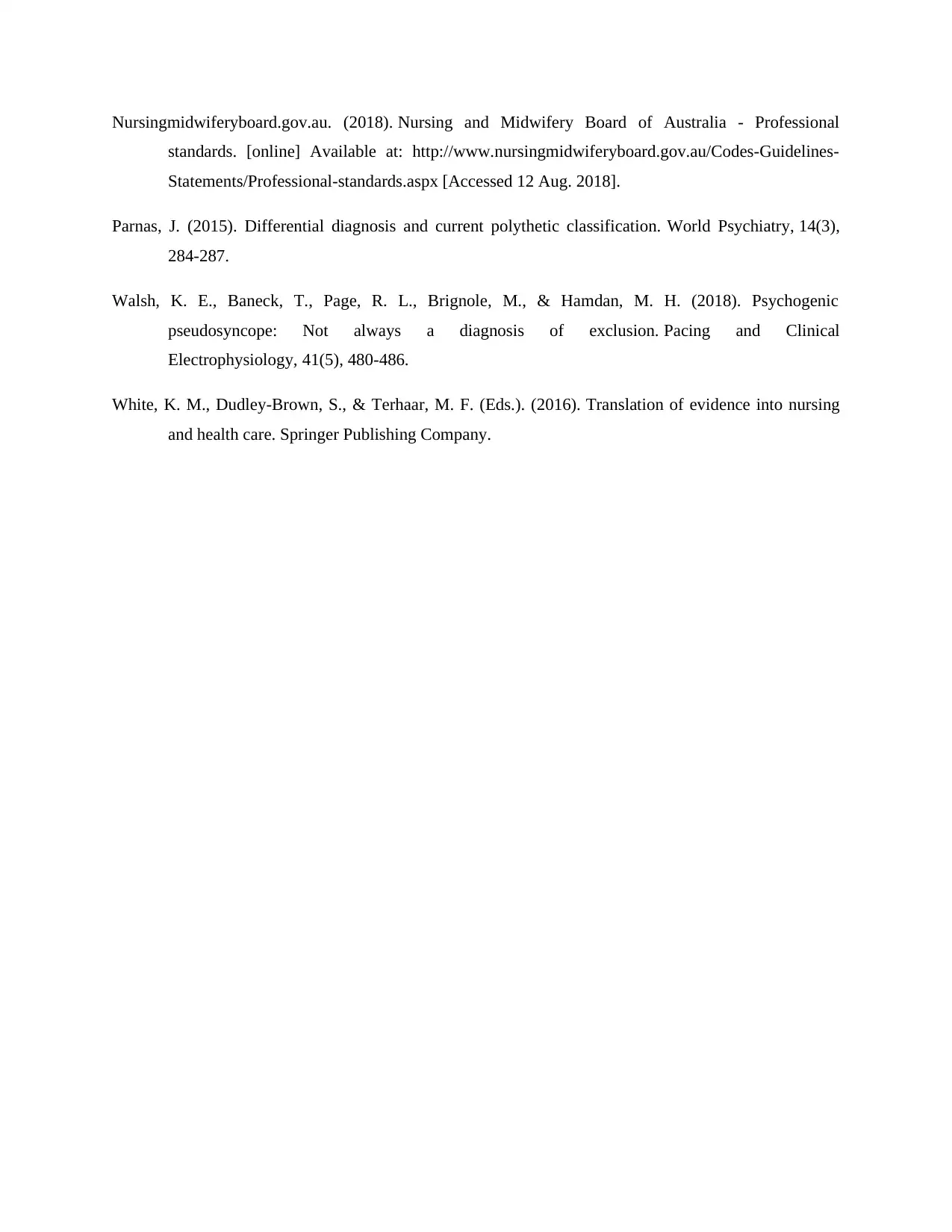
Nursingmidwiferyboard.gov.au. (2018). Nursing and Midwifery Board of Australia - Professional
standards. [online] Available at: http://www.nursingmidwiferyboard.gov.au/Codes-Guidelines-
Statements/Professional-standards.aspx [Accessed 12 Aug. 2018].
Parnas, J. (2015). Differential diagnosis and current polythetic classification. World Psychiatry, 14(3),
284-287.
Walsh, K. E., Baneck, T., Page, R. L., Brignole, M., & Hamdan, M. H. (2018). Psychogenic
pseudosyncope: Not always a diagnosis of exclusion. Pacing and Clinical
Electrophysiology, 41(5), 480-486.
White, K. M., Dudley-Brown, S., & Terhaar, M. F. (Eds.). (2016). Translation of evidence into nursing
and health care. Springer Publishing Company.
standards. [online] Available at: http://www.nursingmidwiferyboard.gov.au/Codes-Guidelines-
Statements/Professional-standards.aspx [Accessed 12 Aug. 2018].
Parnas, J. (2015). Differential diagnosis and current polythetic classification. World Psychiatry, 14(3),
284-287.
Walsh, K. E., Baneck, T., Page, R. L., Brignole, M., & Hamdan, M. H. (2018). Psychogenic
pseudosyncope: Not always a diagnosis of exclusion. Pacing and Clinical
Electrophysiology, 41(5), 480-486.
White, K. M., Dudley-Brown, S., & Terhaar, M. F. (Eds.). (2016). Translation of evidence into nursing
and health care. Springer Publishing Company.
1 out of 10
Related Documents
Your All-in-One AI-Powered Toolkit for Academic Success.
+13062052269
info@desklib.com
Available 24*7 on WhatsApp / Email
![[object Object]](/_next/static/media/star-bottom.7253800d.svg)
Unlock your academic potential
© 2024 | Zucol Services PVT LTD | All rights reserved.





